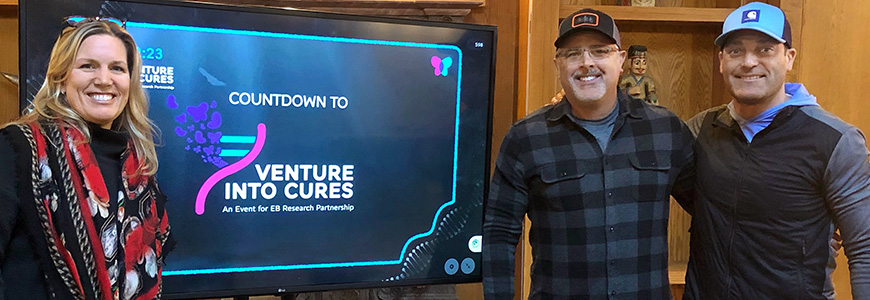William Blair client Dr. Jeff Heddles began his journey as a focal donor to help find a cure for a rare childhood skin disease while attending a Pearl Jam Concert in California the fall of 2021. On stage alongside the rock ‘n’ roll band’s lead singer Eddie Vedder was a child about seven years old playing a tambourine.
“He was having a ball on stage but sadly was wrapped in bandages,” Heddles recalls. “Seeing him and his performance inspired me to learn more about his condition.”
Heddles later learned that the child, “Mikey,” was suffering from Epidermolysis Bullosa (EB), a devastating and life-threatening genetic skin disorder that affects children from birth. Currently, there are no therapies or cures in the U.S. The only treatment available to patients is wrapping their blistering skin with bandages. But EB Research Partnership (EBRP), the world’s largest nonprofit to find a cure, is on a mission to change that. Vedder and his wife Jill are co-founders of EBRP, inspired to take action when a childhood friend had a son born with EB.
“I’m sure they wouldn’t have thought that they would have had a half-million-dollar donor just because I saw a Pearl Jam show,” Heddles says. “I was just in the right place at the right time.”
Fast forward, this past November Heddles was honored to introduce EB’s annual online gala, Ventures Into Cures, a star-studded lineup of celebrities to raise funds for EB research that featured appearances and performances by Will Ferrell, Dana Carvey, Red Hot Chili Peppers, Emma Watson, Eddie Vedder, and more.
“It was a life changing experience,” Heddles says. “Once you learn how awful this disease is and the amazing research EBRP is funding to find a cure, it changes your life’s perspective. It is really exciting to be a part of that.”

Heddles, a William Blair private wealth client, says helping others is a value his father instilled in him at an early age. His late father was a successful entrepreneur and business owner known for supporting many community causes. So last year when Heddles retired as a chiropractor from the practice he began 20 years ago in Chicago—and the family sold his dad’s steel business—he shifted his life’s focus to philanthropy. Along with EBRP, Heddles is on the board of the West Point School of Music, a school on Chicago’s south side with a mission to engage youth through music. He is also a supporter of the D’Addario Foundation, a nonprofit that transforms the lives of children through music and supports West Point.
Innovative Venture Philanthropy Model
Heddles is particularly excited about the progress EBRP is making to find a cure and its innovative venture philanthropy model that is enabling more research. He worked with Laura Coy, who heads philanthropic strategy for William Blair, to find and vet EBRP.
“It was an incredible opportunity to work with Jeff to match his passion for music, particularly Eddie Vedder’s, with his desire to make a truly visible impact,” says Coy. “That’s what philanthropy is all about. It’s your personal passion and a quest to make a difference or solve problems. Jeff is all about curing EB and seeing the impact during these children’s lifetimes.”
Since EBRP was founded in 2010, it has created the world’s largest genomic data project for EB, sharing clinical and genomic data across the world to coordinate and maximize the efficiency of research into finding a cure. EB is the result of one mutated gene as opposed to other diseases like cancers where there can be multiple genes involved. With advances in gene editing, finding a cure for rare monogenic diseases are within reach. EBRP has raised $50 million to fund 100+ research projects in the U.S., U.K., Canada, Australia, Germany, and India. And through venture philanthropy, all returns on investments fund further research.
Its venture philanthropy approach was cited by Harvard Business School as an innovative funding model, which is crucial for organizations focused on curing rare diseases. EB only affects about 500,000 people worldwide making it difficult to attain patient data and funding. EBRP’s funding model leverages concepts from principal investing operating similar to an early stage investor. When making a grant to a research project, EBRP requires a venture philanthropic agreement be in place to retain a recurring donation stream if the therapy or product is commercially successful.
Harvard cites one example where EBRP grew $500,000 in funding for a gene-therapy project six times, with all of it going back to fund more EB research.
“If this is going to be commercialized, the foundation should be able to get a piece of that to represent our shareholders, which are the patients, and put every single one of those dollars right into more research and science until we cure the disease,” says Michael Hund, CEO of EBRP. “Not only is that an innovative model but it’s a really sustainable model.”
The great news is that the first therapy, a topical cream used to heal the skin, is currently in a successful FDA trial and could be approved for use in February. Krystal Biotech developed the gene therapy and EBRP was one of the early funders of the research beginning in 2017.
“We’re on the cusp of an exceptionally viable therapy, if not a cure, certainly within the next 10 years,” Heddles says. “But because EB is an obscure disease, there’s always the question of whether treatments will be affordable. We might only be halfway done with this. But first is the cure.”



